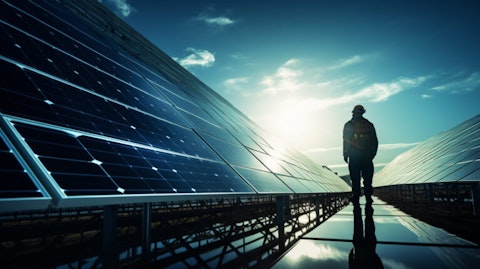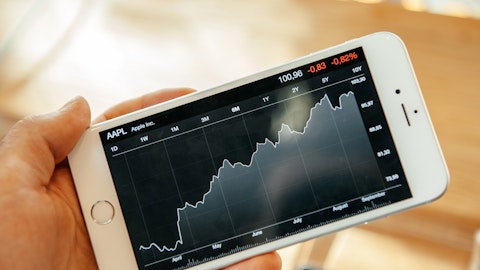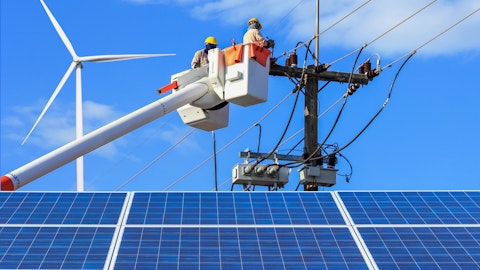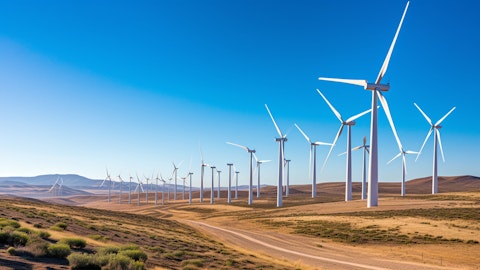SolarEdge Technologies, Inc. (NASDAQ:SEDG) Q3 2023 Earnings Call Transcript November 2, 2023
Operator: Welcome to the SolarEdge Conference Call for the Third Quarter ended September 30, 2023. This call is being webcast live on the company’s Web site at www.solaredge.com in the Investors section on the Events/Calendar page. This call is the sole property and copyright of SolarEdge with all rights reserved, and any recording, reproduction or transmission of this call without the express written consent of SolarEdge is prohibited. You may listen to a webcast replay of this call by visiting the Event/Calendar page of the SolarEdge Investor Web site. I would now like to turn the call over to J.B. Lowe, Head of Investor Relations for SolarEdge.
J.B. Lowe: Thank you, Leo, and good afternoon, everyone. Thank you for joining us to discuss SolarEdge’s operating results for the third quarter ended September 30, 2023 as well as the company’s outlook for the fourth quarter of 2023. With me today are Zvi Lando, Chief Executive Officer; and Ronen Faier, Chief Financial Officer. Zvi will begin with a brief review of the results for the third quarter ended September 30, 2023. Ronen will then review the financial results for the third quarter followed by the company’s outlook for the fourth quarter of 2023. We will then open the call for questions. Please note that this call will include forward-looking statements that involve risks and uncertainties that could cause actual results to differ materially from management’s current expectations.

A solar array, reflecting the sun’s rays, with a technician in the foreground.
We encourage you to review the Safe Harbor statements contained in our press release, the slides published today and our filings with the SEC for a more complete description of such risks and uncertainties. All material contained in the webcast is the sole property and copyright of SolarEdge Technologies with all rights reserved. Please note, this presentation describes certain non-GAAP measures, including non-GAAP net income and non-GAAP net diluted earnings per share, which are not measures prepared in accordance with U.S. GAAP. The non-GAAP measures are presented in this presentation because we believe that they provide investors with the means of evaluating and understanding how the company’s management evaluates the company’s operating performance.
These non-GAAP measures should not be considered in isolation from, as substitutes for, or superior to financial measures prepared in accordance with U.S. GAAP. Listeners who do not have a copy of the quarter ended September 30, 2023 press release or the supplemental material may obtain a copy by visiting the Investor Relations section of the company’s Web site. Now, I will turn the call over to Zvi.
Zvi Lando: Thank you, J.B. Good afternoon, and thank you all for joining us on our conference call today. As reflected in our preliminary announcement a few weeks ago and in the guidance we are giving today, we are going through challenging times in terms of general market dynamics and specific inventory trends related to our products. In the call today, we will share details of third quarter sales and megawatt sell-through data aggregated from distributors in some of the regions and our latest estimates of underlying business levels in the near future, and estimate how long it will take to reach the associated revenue level. Before getting into the regional picture, I want to start with high level perspective. During 2022, and in particular the second half of 2022, our industry went through an unprecedented surge in demand, which we attributed to geopolitical and other reasons discussed in our prior call.
Indicators in the beginning of 2023 were that demand would continue to increase this year, in particular in Europe. This led to a buildup of significant backlog for our products, in particular because at the time, we faced operational challenges to supply all the demand. Specifically, this was related to three phase commercial inverters that were in high demand and low supply in the late part of 2022, and our supply improved dramatically in early 2023. Additionally, in early 2023, we released in Europe a differentiated three phase residential offering of a backup inverter and battery, which our customers were waiting for and excited to adopt. As a result of these factors, our shipments in the first half of 2023 were at record levels, and we were in the process of increasing capacity to meet the elevated channel demand.
However, market demand began to slow in the third quarter, and distributors began to experience financial challenges. As a result, we received a large amount of requests to cancel or push out orders. We should note that while these orders are technically binding on our distributors, the nature of our relationship with these customers assess that we accommodated most of these requests. As a result, our third quarter revenue and fourth quarter expected revenues are significantly lower than our run rate in recent quarters, while the infrastructure we built to support the anticipated sales growth has created a burden that is putting pressure on our margins in the near term. I will describe when and how we believe our revenue will reach a level that reflects stabilized market demand post inventory corrections.
And Ronen would elaborate on the margin and financial infrastructure impact of the short-term actions we are taking. Now let’s go over the highlights of our third quarter results. We concluded the quarter with revenues of approximately $725 million. Revenues from our solar business were $676 million, while revenues from our non-solar businesses were $49 million. This quarter, we shipped 3.3 million power optimizers and 274,000 inverters. Additionally, this quarter, we shipped 121 megawatt hours of residential batteries, down from 269 megawatt hours last quarter. Our solar business revenues declined quarter-over-quarter by 29% and by 14% year-over-year, driven by market slowdown and high inventory of our products in the channels. Moving now to market-by-market dynamics.
Starting in Europe, as already described, during the second part of the third quarter, we experienced significant unexpected cancellations and push out of existing backlog from our European distributors. Although the dynamics are consistent with what we caution during our second quarter earnings call, the magnitude grew much greater than we anticipated. We also note that the European market is a diverse one, and each country comes with its own regulatory environment and energy-related dynamics. I will give some color on what we see on per country basis in some of the top countries in which we operate. According to market reports, Germany, which is the largest rooftop solar market in Europe, is on track this year to connect to the grid more than 10 gigawatts of solar compared to 7.5 gigawatts in 2022.
The government has announced the long-term goal to reach 215 gigawatts by 2030, which in order to be achieved would require annual installation of approximately 20 gigawatts per year, indicating the expected long-term strength of the German market. Consistent with this trend, our residential energy hub three phase inverter introduced in April of this year and our three phase battery are optimized for the German market. We continue to see good adoption of this solution. From a demand perspective, our sell through in Germany in the third quarter was up 44% year-over-year and down 37% quarter-over-quarter from the peak levels typically seen in the second quarter. The Swiss and Austrian market, which revenue wise are about a third of the size of our revenue in Germany, utilize the same portfolio of products as Germany, and similarly grew significantly so far in 2023, and are expected to continue to grow in 2024.
In fact, Switzerland was a record revenue quarter for us in Q3, and we are well positioned to continue growth in these markets in 2024. Sell through in these markets was up 213% year-over-year and up 42% quarter-over-quarter. Moving to the Netherlands. The market in the Netherlands is dramatically down from peak levels due to uncertainty around government policies and the phase out of net metering, which may become clear after the elections in November. That said, there are several trends that we believe will work in our favor in the mid and long term in this market. The increased implementation of dynamic tariffs combined with the phase out of net metering is likely to increase the number of full system installations with batteries, EV charging and advanced home energy management capabilities similar to the SolarEdge ONE platform that we launched at Intersolar in June.
Additionally, depending on changes in regulation, the Netherlands could have a large potential for upsell and retrofit of existing installations with additional products, including batteries and EV chargers, as well as software capabilities, which is a great opportunity for SolarEdge given our market leadership and vast installed base in this country. Furthermore, there has been a push for new residential homes to be built with three phase service in what has traditionally been a single phase market. This will enable the use of our differentiated three phase offering that we have been successful with in Germany, as described earlier. Sell through of our products in the combined Belgian and Netherlands market were up 4% year-over-year and down 25% quarter-over-quarter.
In Italy, the residential market has been sluggish since the Superbonus tax credit ended earlier this year. And we saw our point of sale of residential products in this market decline year-over-year by 48%. On the other hand, the commercial market has seen significant growth and has largely offset the decline in the residential market. Our point of sale data for commercial products in Italy was up 216% year-over-year in the third quarter. Overall, our megawatt filter in Italy was up to 85% year-over-year and down 6% quarter-over-quarter. All-in-all, the underlying demand in the European market was strong in the nine-month period ended September 30, although below the much elevated expectation heading into the year leading to the inventory buildup that I described earlier.
On an aggregated basis in Europe, our sell through in the third quarter was up 34% year-over-year and down 22% quarter-over-quarter. Moving to the U.S. We have not seen a significant change in market dynamics since our second quarter call. The market is still being adversely impacted by high interest rates and uncertainties around the pace of adoption of NIM 3.0 systems in California. In commercial, we are seeing a slight improvement as projects that were on hold appear to be moving forward, possibly related to availability of low priced modules. In our data, sell through in the third quarter for residential was down 13% quarter-over-quarter, and commercial was up 8% quarter-over-quarter. Battery sell through was up 31% quarter-over-quarter.
We expect these market dynamics to continue without significant change in the coming quarters. In the rest of the world, our third quarter revenues were relatively stable and we do not see dramatic shifts in overall revenue over the next several quarters. The rest of the world markets are largely dominated by commercial installations, which are impacted by the higher interest rate environment. Local dynamics in specific countries are largely offsetting each other. Taking into account these market dynamics, we use the demand patterns represented by the sell-through data discussed above to model the time we think it will take to run down the inventory level and have estimated a normalized level of revenue and margin following the inventory corrections.
We used our sell-through data for the third quarter of 2023 as a baseline, and did not include potential additional revenue from new products that we will discuss separately, or market share improvements that we are working on and for which we see positive signs. This modeling currently indicates in a non-inventory challenged environment, a revenue run rate of approximately $600 million to $700 million per quarter. Using this model and looking at inventory data that we received from our distributors, we estimate the correction could take two to three quarters of gradual improvement quarter-over-quarter. Moving to the operational side. We are, of course, already taking measures to adjust our cost base to this projected level of business. To align with reduced demand, we have discontinued manufacturing of our products in Mexico and reduced capacity in China.
In parallel, we are ramping up manufacturing in our U.S. facility, where we expect to ship 12,000 energy hub inverters in the fourth quarter ramping to a run rate of 50,000 units per quarter. Additionally, we are targeting for a second site to begin producing commercial inverters and optimizers by the second quarter of 2024. An additional step of cost reduction is our decision to discontinue our light commercial vehicle e-Mobility activity, which we consider as non-core. And as such, we delivered final kits to Stellantis in October. We intend to continue making adjustments to achieve the levels of profitability at the revenue run rate discussed earlier, which Ronen will elaborate on in his comments. Moving on to products. We recently installed our first 330 kilowatt inverter in the U.S. following similar installations that have been running for some time in Europe and Asia.
This product is specifically targeting community solar and Agri PV applications. We will be ramping production in the fourth quarter for further deliveries globally in 2024. This will expand our offering for these ground mount applications beyond the tracker product that we released a few months ago. This quarter, we are also announcing the approval by our Board of Directors of a share repurchase program, which reflect our confidence in the future growth of our company. The plan authorizes the repurchase of up to 300 million of the company’s stock through 2024. I would like now to address the ongoing situation in Israel and how it is affecting our company. We have seen no disruption to our ability to manufacture and deliver products and services to our customers.
Approximately 11% of our Israel-based workforce, which is approximately 6% of our global workforce, has been called up for reserve duty and we are prioritizing and reallocating resources between projects to make sure that the impact to our business is minimum. To conclude my remarks, setting aside recent and upcoming inventory corrections, we believe the underlying demand for our products, while at a reduced level from the first half of 2023, is above our projected fourth quarter revenue and represents our strong position in the markets. On top of this, our global sales force is energized and focused on gaining market share, based on the products and improvements made to our core portfolio in the last 12 to 18 months. This together with the new products we have developed, for the new segments we have entered should create an opportunity for incremental growth at a faster rate than the solar market in the coming year.
I will now hand it over to Ronen.
Ronen Faier: Thank you, Zvi, and good afternoon, everyone. The financial review includes a GAAP and non-GAAP discussion. Full reconciliation of the pro forma to GAAP results discussed on this call is available on our Web site and in the press release issued today. Segment profit is comprised of gross profit for the segment less operating expenses that do not include amortization of purchased intangible assets, impairment of goodwill and intangible assets, stock-based compensation expenses and certain other items. Total revenues for the third quarter were $725.3 million, a 27% decrease compared to $991.3 million in the last quarter, and a 13% decrease compared to $836.7 million for the same quarter last year. Revenues from our solar segment, which include the sales of residential batteries and trackers, were $676.4 million, a 29% decrease compared to $947.4 million last quarter, and a 14% decrease compared to $788.6 million for the same quarter last year.
Total revenues from the United States this quarter were $195.7 million, similar to the last quarter and 22% decrease from the same quarter last year, representing approximately 29% of our solar revenues. Total revenues from Europe were $419.2 million, a 39% decrease from the last quarter and 12% increase from the same quarter last year, representing 62% of our solar revenues. In Europe, we saw a meaningful quarter-over-quarter revenue dropped across the board with noticeable declines in Germany with 43% decline, Netherlands with 40% decline, UK with 41% decline, and Poland with 67% decline. On a positive side, revenues in Switzerland grew this quarter by 11%, reaching a record high. And in France, revenues grew by 37%. A significant portion of our revenues decline in Europe are attributed to lower sales of batteries or a combination of inventories in the beginning of the quarter and lower demand than anticipated by our customers led to an accumulation of large quantities in the channels.
Rest of world solar revenues were $61.5 million, a 3% decrease compared to the last quarter and flat compared to the third quarter of last year, representing approximately 9% of our solar revenues. On a megawatt basis, we shipped 774 megawatts of inverters to the United States, 2.6 gigawatt to Europe, and 467 megawatts to the rest of the world, totaling 3.8 gigawatts of quarterly inverter shipments. During the quarter, we continued to ship a higher ratio of inverters related to optimizers in order to catch up with previous optimizer sales. During the quarter, 66% of our megawatt shipments were commercial products and the remaining 34% were residential. Just at the beginning of the year, we have shipped approximately 7.1 gigawatts of commercial products worldwide compared to the 5.2 gigawatts shipped in all of 2022.
In the third quarter, we shipped 121 megawatt hour of our residential batteries, a decrease from 269 megawatt hour last quarter. While our battery sales in Europe decreased significantly, battery sales in the United States remained relatively stable, and we continue to see a steady increase in installation rates in the United States. Average selling price per watt this quarter, excluding battery revenues, was $0.164, a 13% decrease from $0.188 last quarter. This ASP per watt decrease is predominantly a result of a lower optimizer shipment mix during the quarter and increase in the weight of commercial inverters in our overall mix and the weaker euro. In general, our prices did not change this quarter. Our battery ASP per kilowatt hour was $475 slightly down from $479 last quarter, mostly a result of a weaker euro.
Revenues this quarter from our non-solar segment were $48.7 million, an increase from $43.7 million last quarter. Consolidated GAAP gross margins for the quarter was 19.7%, down from 32% in the prior quarter and down from 26.5% in the same quarter last year. Non-GAAP gross margin this quarter was 20.8% compared to 32.7% in the prior quarter, and 37.3% for the same quarter last year. Gross margin for the solar segment was 24% compared to 34.7% in the prior quarter and 28.3% in the same quarter last year. I would like now to address the decrease in our gross margins in the third quarter and provide color on the fourth quarter and the quarters ahead. Our cost of goods sold are comprised of variable costs that are correlated to the product mix and volume shipped such as manufacturing costs, shipping and logistics expenses, et cetera.
In addition, we have other indirect costs that are not volume or mix specific, such as warranty costs related to our existing and growing install base, contract manufacturer claims related to adjustment made to the manufacturing level and costs associated with our operation and support department, et cetera. These costs are not correlated to the volumes of product shipped, and usually require some time to be adjusted to significant changes in revenues. Of the total quarter-over-quarter reduction of 1,070 basis points in the solar segment margins, approximately 160 basis points are attributed to higher portion of commercial products and lower portion of optimizers within our product mix, customer mix and the devaluation of the euro against the U.S. dollar.
The remaining 910 basis points decline are mostly related to the allocation of our indirect costs over a lower revenue base. Around a third of the 910 basis points are related to warranty and service costs across our existing and growing install base that do not change when revenues decline. Approximately 200 basis points are related to the allocation of our operations, quality and support organizations over lower revenues. The remaining amount is a result of a higher percentage of logistic costs due to increased storage expenses and underutilization costs to contract manufacturers. In the third quarter, we have also recorded a one-time expense related to the discontinuation of manufacturing in Mexico. These diseconomies of scale will persist and even worsen in the fourth quarter as revenues are abnormally low.
Noteworthy is that these indirect costs were down quarter-over-quarter on an absolute basis. And due to the actions in process, we expect them to be significantly lower again in the fourth quarter in absolute value. We expect margins to gradually improve in the first and second quarters of the next year as we will continue to reduce costs and as our revenues return to a more normalized level. Gross margin for our non-solar segment was minus 22.8% compared to minus 9.6% in the previous quarter. On a non-GAAP basis, operating expenses for the second quarter were $128 million or 17.6% of revenues compared to $133.3 million or 13.4% of revenues in the prior quarter and $108.3 million or 12.9% of revenues for the same quarter last year. Non-GAAP operating income for the quarter was $23.1 million compared to $191 million in the previous quarter and $120.2 million for same period last year.
The solar segment generated operating income of $45.7 million this quarter, down from $207 million in the last quarter. The non-solar segment generated an operating loss of $22.6 million compared to an operating loss of $16.1 million in the previous quarter. Non-GAAP financial loss for the quarter was $7.4 million compared to a non-GAAP financial income of $4.4 million in the previous quarter. The loss was largely a result of a weaker euro during the quarter. Our non-GAAP tax expense was $46.6 million compared to $38 million in the previous quarter and $34.5 million for the same period last year. The unusual result is mostly due to the amortization of R&D expenses for tax purposes as well as temporarily higher tax rate related to the quarterly tax calculation methodology.
We expect our annual non-GAAP tax rate for the entire 2023 to be within 22% to 24%. GAAP net loss for the third quarter was $61.2 million compared to a GAAP net income of $119.5 million in the previous quarter and GAAP net income of $24.7 million in the same quarter last year. Our non-GAAP net loss was $31 million compared to a non-GAAP net income of $157.4 million in the previous quarter, and a non-GAAP net income of $54.1 million in the same quarter last year. GAAP net diluted loss per share was $1.08 for the third quarter compared to a GAAP net diluted earnings per share of $2.03 in the previous quarter, and a GAAP net diluted earnings per share of $0.43 for the same quarter last year. Non-GAAP net diluted loss per share was $0.55 compared to a non-GAAP net diluted earnings per share of $2.62 in the previous quarter, and non-GAAP net diluted earnings per share of $0.91 in the same quarter last year.
As mentioned by Zvi, we expect that the stabilized solar revenue levels after the inventory correction has run its course will be approximately $600 million to $700 million quarterly. Under this scenario, corporate non-GAAP gross margins are targeted to be 30% to 32%, including approximately 500 basis points of benefits from IRA manufacturing tax credit and operating profit margins are targeted to be at 11% to 14% after implementing cost reduction activities. I reiterate that this scenario is based on no improvement in demand from our third quarter sell through levels and assumes no incremental revenues or margin from new products. Turning now to the balance sheet. As of September 30, 2023, cash, cash equivalents, bank deposits, restricted bank deposits and investments were $1.5 billion.
Net of debt, this amount is $831.4 million. This quarter, cash generated from operations was $40.6 million as a reduction in our receivables account, and raw materials inventories were partially offset by an increase in finished goods inventories. As we had anticipated, we swung back to cash flow from operations generation in the third quarter and we expect to see greater cash flow from operations in the fourth quarter. Accounts receivable net decreased this quarter to $940 million compared to $1.15 billion last quarter, representing 149 days outstanding. This increase in customers’ days sales outstanding resulted from extended payment terms provided to our customers, especially in Europe, in order to assist them handling with higher inventory levels than desired, as previously described.
As of September 30, our inventory level net of reserves was at $1.2 billion compared to $984.2 million in the last quarter. The increase is solely attributed to higher finished goods inventories, a result of the abrupt slowdown in shipments offset by a decrease in raw material inventory. Turning to our guidance for the fourth quarter of 2023. We’re guiding revenues to be within a range of $300 million to $350 million. We expect non-GAAP gross margin to be within a range of 5% to 8%, including approximately 130 basis points of net IRA manufacturing tax credit. We expect our non-GAAP operating expenses to be within the range of $126 million to $130 million. Revenues from the solar segment are expected to be within the range of $275 million to $320 million.
Gross margin from our solar segment is expected to be within the range of 7% to 10%, including approximately 130 basis points of net IRA manufacturing tax credit. I will now turn the call over to the operator to open it up for questions.
See also 25 Funny Prank Call Ideas for your Boyfriend and 30 Most Interesting Cities in America.
Q&A Session
Follow Solaredge Technologies Inc. (NASDAQ:SEDG)
Follow Solaredge Technologies Inc. (NASDAQ:SEDG)
Operator: [Operator Instructions]. We’ll take our first question from Philip Shen of ROTH MKM.
Philip Shen: Hi, everyone. Thanks for taking my questions. I want to explore the correction cadence some more as it relates to Q4 of this 300 million to 350 million revenue range. And you talked about how things could grow gradually in the coming two to three quarters, or the subsequent two to three quarters. So can you quantify in any way Q1, Q2 and even Q3 is kind of a revenue number with either a three or four in front of it more reasonable? And then when we get back to Q4, once your post correction, you jump right away to that 600 million to 700 million. And then as it relates to margins, could you do the same kind of sketch for that as well? You talked about things gradually improving. But the margin challenge this quarter was for the guide here in Q4 very much has to do with mix. Would you expect your mix to be very similar for Q1 through Q3 of next year as well? Thanks.
Ronen Faier: Okay. First of all, thanks for the question. I hope that I’ll capture everything. If not, please correct me. So I will start by saying that forecasting the cadence of change is, in particular, complicated right now, because of the fact that the changes that we’ve seen were relatively fast. But in a way that we are analyzing the markets, and we analyze them based on U.S., Europe and rest of the world, we’re basically looking at the overall shipments that we did compared to the rate of sell-through data, as Zvi mentioned in his prepared remarks. And when we look at them, we basically see that right now, the numbers that we see are representing approximately 50% of our normalized level. Now when it comes to the correction, there is a little bit of difference I would say between the U.S. and Europe.
First of all, starting from Europe, we usually see that Q4 is a down quarter compared to Q3 and then Q1 is not necessarily up compared to Q4 because of seasonality. And here winter plays a very important role. The way that we see it is that we should see a higher grossing or revenues in Q1 in Europe already, because, first of all, we do understand that in the composition of the inventory within the distribution channels, we have both commercial and residential products, they’re not evenly distributed. And therefore, we believe that some of the products even though maybe on let’s say single phase, you see a little bit of a higher revenue, a sort of higher inventory than commercial, they will run out of commercial and we will need to grow a little bit faster.
We see, for example, that in the last quarters, we shipped a little bit more inverters than optimizers. We believe that right now, optimizers’ level may be a little bit lower than should be at the end of Q1. And therefore, we do expect to see a relatively linear growth in Europe going from this quarter into let’s say second and third quarter, again, with heavy reliance on how winter looks like. If it is going to be a light winter where you see a lot of installations as you saw last year, you will see a little bit of a steeper growth from Q4 to Q1 and then a little bit of a slower growth to Q2 and then back to Q3. If it’s going to be a hard winter, then you will see a little bit of a flatter line compared to Q4 but then a bigger increase. When it comes to the U.S., in the U.S., we actually do not expect a lot of changes in the overall situation of our revenues, because as we’ve mentioned since the beginning of the year, this is a market where it’s relatively predictable, or the slowdown was relatively predictable.
The channels are behaving in a more linear manner. You don’t see so much seasonality as you can see. And therefore, we expect to see I would say relatively similar revenues let’s say from this quarter to the following quarters, maybe with a little bit of slowdown in Q4, because of the end of the year. And rest of the world is expected to be I would say relatively similar with a small linear growth. So now I’ll try to summarize how things would look like? Because if we see that U.S. and rest of world should be I would say relatively similar to where they are today with again a little bit of a drop at the beginning in Q4, we do expect to see I would say pretty linear growth from Q4 into let’s say Q3 where we may normalize that the 600 million to 700 million should be relatively — sorry, from Q1 until the third quarter where we’re supposed to be seeing the 600 million to 700 million, we should be pretty linear.
If we will see that the winter is going to be a little bit lighter, we will see more impact on Q1. And then yes, it may be starting with a four. But again, right now, I will simply need to see how the winter develops there and how the overall inventory clearing is going away. From a margin point of view, it’s a little bit different because on the variable areas, we do not see major changes happening over the next three quarters. The price that we pay for our product from bill of material point of view, of course, this is something that does not change materially. The thing that will really get a little bit better as we move forward is all of I would call non-variable items. So let’s try to look at some of them. First of all, as mentioned in the prepared remarks, when you work with contract manufacturers and as good as they are in supporting you, after building a very large capacity aiming at growth that of course we see now that is not happening, we see that our contract manufacturers have fixed costs that we will have to help them cover when the changes or the reduction in the production level is going down.
And this is weighing on our revenues both in Q4 and in Q1 because this is the time that it takes for them to make these adjustments and especially given the fact that at that time, the basis of revenues is going to be also lower. So therefore, the diseconomies of scale are working extra hours. We believe that around Q2 we will have much less of these charges that will go away. At the same time we have prior to any cost reductions that we will do in efficiencies relatively flat expenses on the support department, because we do not want to reduce the support level that we give today to our existing fleet and to our operation team. And therefore here, it’s mostly going to be related to the fact that the more revenues you have, you have a higher denominator and therefore the percentage is going a little bit better.
So if I tried to summarize all of this, here I do expect to see that you will not see a linear growth in gross margins, but it will be more tilted, or the improvement will be more tilted towards again second quarter of 2024 and the third quarter. This is also by the way related to the fact that we will continue to ramp up our U.S. factory and see more IRA. So it’s a lot of moving parts, but I would say quite linear revenue return and less linear more inclined towards Q2 gross margin change. And again, sorry for the many moving parts but that’s the complexity of the business.





